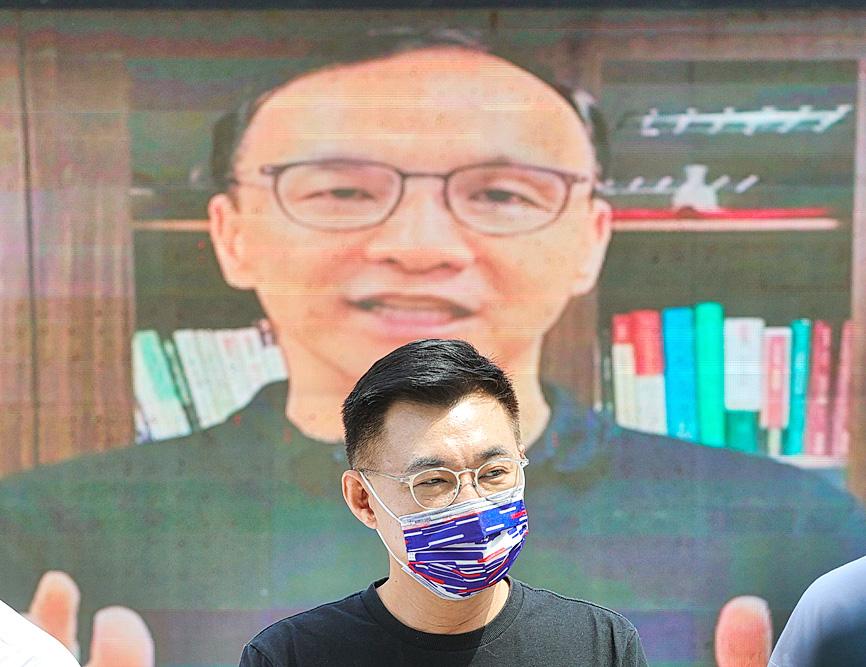Chinese Nationalist Party (KMT) Chairman Johnny Chiang (江啟臣) yesterday called for relations with China to be returned to a state of “no unification, no independence and no use of force,” and proposed the establishment of a committee on the development of peace across the Taiwan Strait.
Chiang made the remarks at the KMT’s weekly Central Standing Committee meeting in Taipei — the final one over which he would preside before taking a leave of absence next week to campaign for re-election as KMT chairman.
He began his address by thanking the nation’s delegation for its success at the Tokyo Olympic Games, which closed on Sunday, adding that the KMT would stand with the athletes and work to improve the domestic sports environment.

Photo: CNA
This year’s Olympic Games have revealed “deep concerns,” he said, as instead of easing tensions between the two sides of the Taiwan Strait, the Games provoked hostile comments online.
“People on both sides of the Strait once again fell into a downward ‘malicious spiral,’” Chiang said. “In the past, the two sides of the Strait have had the glory of peaceful and stable development, to which the 1992 consensus was key.”
The so-called “1992 consensus,” a term former Mainland Affairs Council chairman Su Chi (蘇起) in 2006 admitted making up in 2000, refers to a tacit understanding between the KMT and the Chinese Communist Party that both sides of the Taiwan Strait acknowledge there is “one China,” with each side having its own interpretation of what “China” means.
Since the KMT’s proposal in September last year of the concept of a “1992 consensus based on the Republic of China Constitution,” public understanding and trust in the consensus has gradually recovered, Chiang said.
The notion of a “1992 consensus based on the Republic of China Constitution” would allow the “1992 consensus” to “continue to become the main option for Taiwanese,” as well as earn the KMT public trust and stabilize cross-strait relations, he said.
The policy of “no unification, no independence and no use of force” proposed by the administration of former president Ma Ying-jeou (馬英九) ensured peace and stability across the Taiwan Strait, Chiang said.
Over the past five years, the Democratic Progressive Party and President Tsai Ing-wen (蔡英文) have shown that “relying on empty words alone cannot maintain the peaceful status quo of the past,” he said.
Chiang proposed “returning to a peaceful state of ‘no unification, no independence and no use of force.’”
Of primary interest would be to build a consensus within Taiwan, he said.
It would be necessary to launch a “cross-strait peace development committee,” Chiang said, adding that such a committee could either be established by the KMT or set up jointly with other political parties and organizations.
The committee could serve as a national forum on the future of cross-strait relations and promote meaningful dialogue across generations and political affiliations, he said.
The KMT is scheduled to hold elections for its chairperson and delegates of its National Congress on Sept. 25.
KMT members have to register their candidacy on Monday or Tuesday next week.

Taiwanese scientists have engineered plants that can capture about 50 percent more carbon dioxide and produce more than twice as many seeds as unmodified plants, a breakthrough they hope could one day help mitigate global warming and grow more food staples such as rice. If applied to major food crops, the new system could cut carbon emissions and raise yields “without additional equipment or labor costs,” Academia Sinica researcher and lead author the study Lu Kuan-jen (呂冠箴) said. Academia Sinica president James Liao (廖俊智) said that as humans emit 9.6 billion tonnes of carbon dioxide compared with the 220 billion tonnes absorbed

The Taipei Mass Rapid Transit (MRT) Wanda-Zhonghe Line is 81.7 percent complete, with public opening targeted for the end of 2027, New Taipei City Mayor Hou You-yi (侯友宜) said today. Surrounding roads are to be open to the public by the end of next year, Hou said during an inspection of construction progress. The 9.5km line, featuring nine underground stations and one depot, is expected to connect Chiang Kai-shek Memorial Hall Station to Chukuang Station in New Taipei City’s Jhonghe District (中和). All 18 tunnels for the line are complete, while the main structures of the stations and depot are mostly finished, he

Taipei is to implement widespread road closures around Taipei 101 on Friday to make way for large crowds during the Double Ten National Day celebration, the Taipei Department of Transportation said. A four-minute fireworks display is to be launched from the skyscraper, along with a performance by 500 drones flying in formation above the nearby Nanshan A21 site, starting at 10pm. Vehicle restrictions would occur in phases, they said. From 5pm to 9pm, inner lanes of Songshou Road between Taipei City Hall and Taipei 101 are to be closed, with only the outer lanes remaining open. Between 9pm and 9:40pm, the section is

China’s plan to deploy a new hypersonic ballistic missile at a Chinese People’s Liberation Army Rocket Force (PLARF) base near Taiwan likely targets US airbases and ships in the western Pacific, but it would also present new threats to Taiwan, defense experts said. The New York Times — citing a US Department of Defense report from last year on China’s military power — on Monday reported in an article titled “The missiles threatening Taiwan” that China has stockpiled 3,500 missiles, 1.5 times more than four years earlier. Although it is unclear how many of those missiles were targeting Taiwan, the newspaper reported